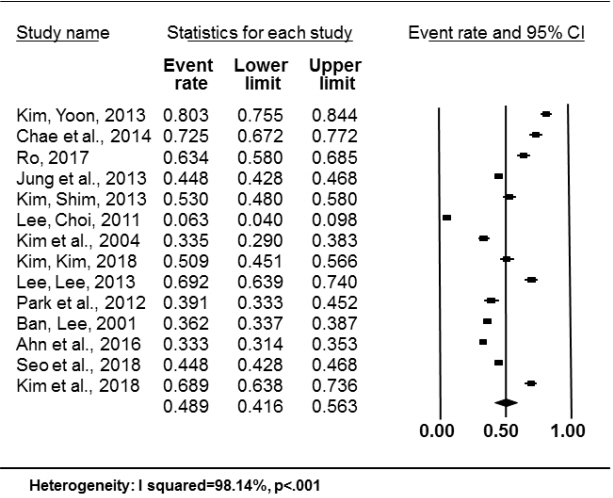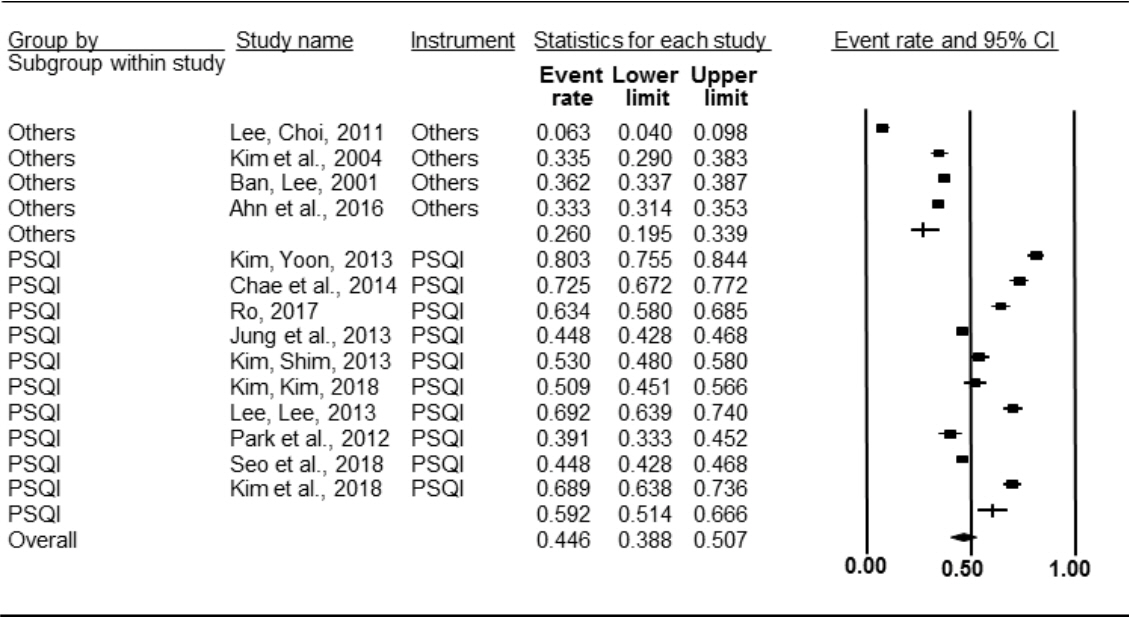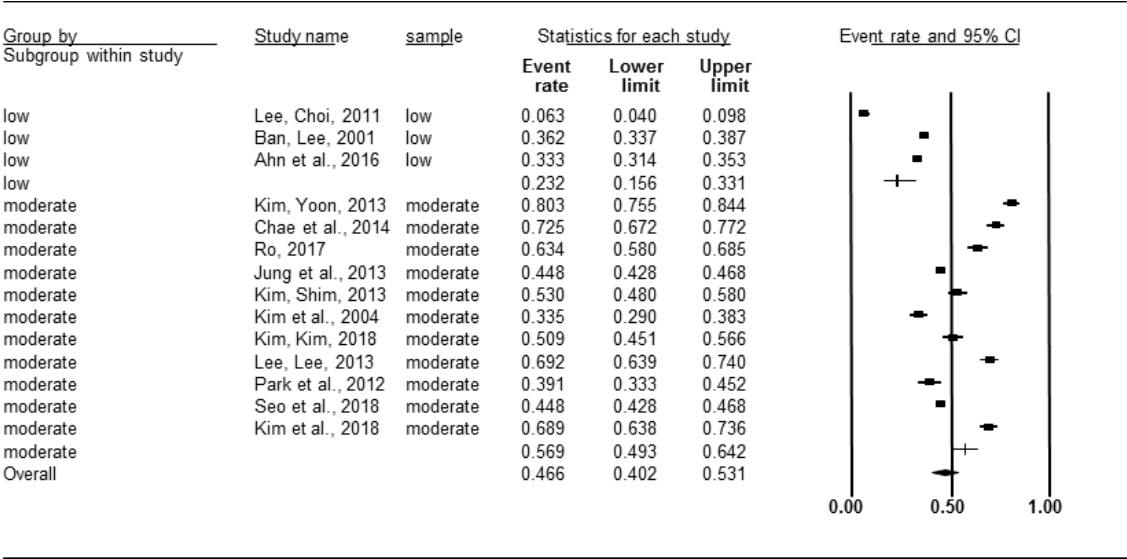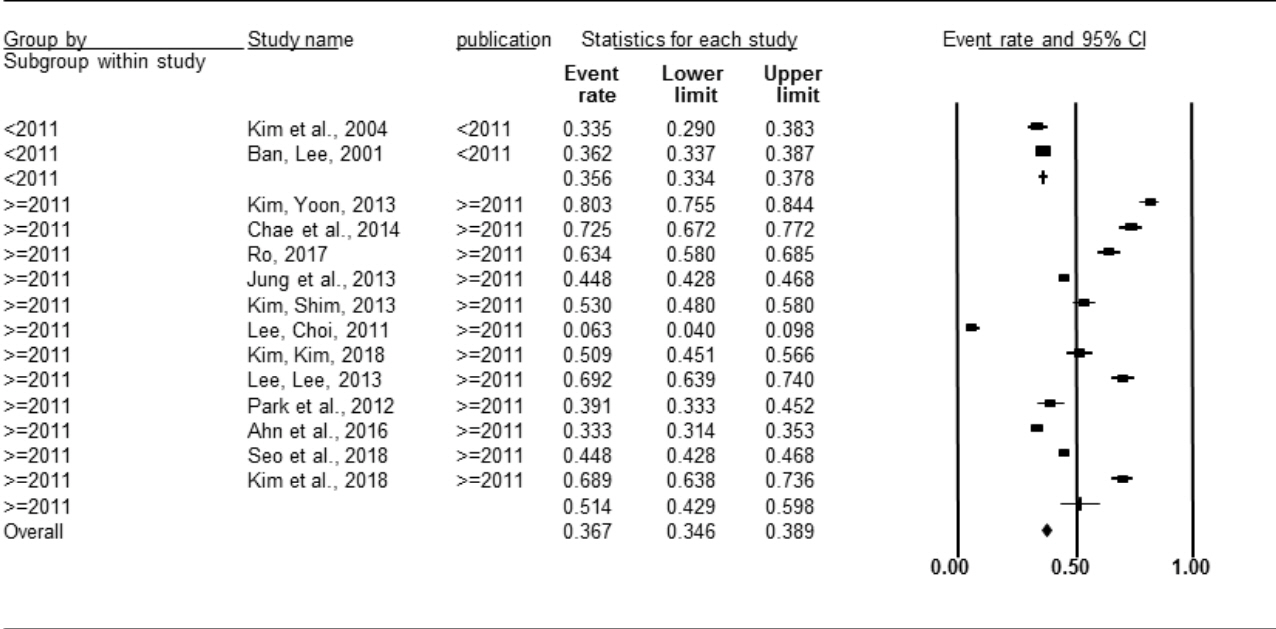Korean J Health Promot.
2020 Jun;20(2):49-57. 10.15384/kjhp.2020.20.2.49.
Prevalence of Sleep Disturbance in Korean University Students: A Systematic Review and Meta-Analysis
- Affiliations
-
- 1Department of Nursing, Wonkwang University, Iksan, Korea
- 2College of Nursing, Ewha Womans University, Seoul, Korea
- KMID: 2503934
- DOI: http://doi.org/10.15384/kjhp.2020.20.2.49
Abstract
- Background
This systematic review and meta-analysis aimed at investigating the current status and prevalence of sleep disturbance in Korean university students and provide evidence to develop appropriate strategies for improving sleep disturbance.
Methods
Pooled prevalence of sleep disturbance in Korean university students was assessed using PubMed, CINAHL, Research Information Sharing Service, National Assembly Library, Korean studies Information Service System, and Korea Citation Index databases. A total of 1,843 studies were retrieved from the literature search, and 14 studies were included in the analysis. Statistical analysis was performed using comprehensive meta-analysis software.
Results
The overall pooled prevalence was 48.9% (95% confidence interval [CI], 41.6-56.3%). Subgroup analyses revealed that the pooled prevalence rates were 59.2% (95% CI, 38.8-50.7%) in the Pittsburgh Sleep Quality Index (PSQI)-based and 26.0% (95% CI, 19.5-33.9%) in non-PSQI-based studies, 23.2% (95% CI, 15.6-33.1%) in low-quality and 56.9% (95% CI, 49.3-64.2%) in moderate-quality studies, 35.6% (95% CI, 33.4-37.8%) in studies published before 2010 and 51.4% (95% CI, 42.9-59.8%) in studies published since 2011.
Conclusions
The prevalence of sleep disturbance is higher in university students. Therefore, further studies are needed to identify sleep problems of university students and gain future-oriented insights to develop mediation strategies.
Figure
Reference
-
1. Chen WL, Chen JH. Sleep deprivation and the development of leadership and need for cognition during the college years. J Adolesc. 2019; 73:95–9.
Article2. Nappier MT, Bartl-Wilson L, Shoop T, Borowski S. Sleep quality and sleepiness among veterinary medical students over an academic year. Front Vet Sci. 2019; 6:119.
Article3. Cahuas A, He Z, Zhang Z, Chen W. Relationship of physical activity and sleep with depression in college students. J Am Coll Health. 2020; 68(5):557–64.
Article4. Chen WL, Chen JH. Consequences of inadequate sleep during the college years: sleep deprivation, grade point average, and college graduation. Prev Med. 2019; 124:23–8.
Article5. Ro HL. Analysis of the relationship among sleep type and sleep quality, and perceived life stress in college students: based on students living in a dormitory. J Korean Data Anal Soc. 2017; 19(2):1011–24.6. Won MH, Shin SH. Influence of interpersonal problems on sleep quality in college students: the mediating role of mental health and moderated mediating role of cognitive emotional regulation. J Korea Converg Soc. 2019; 10(12):525–34.7. Nam G, Lee S, Ji O. The effect of sleep quantity and quality on college students’ interpersonal deviant behavior: a daily diary examination of mediating role of negative affect. Korean J Health Psychol. 2018; 23(2):583–93.8. Kim SH, Min JW, Park BK. The effect of smartphone addiction and stress on sleep quality among university students. J Korea Acad-Ind Coop Soc. 2019; 20(4):112–20.9. Kim KH. Sleep quality through depression in university students. Korean J Youth Stud. 2016; 23(5):379–404.10. Li L, Wang YY, Wang SB, Zhang L, Li L, Xu DD, et al. Prevalence of sleep disturbances in Chinese university students: a comprehensive meta-analysis. J Sleep Res. 2018; 27(3):e12648.
Article11. Mohammadbeigi A, Absari R, Valizadeh F, Saadati M, Sharifimoghadam S, Ahmadi A, et al. Sleep quality in medical students; the impact of over-use of mobile cell-phone and social networks. J Res Health Sci. 2016; 16(1):46–50.12. Gress-Smith JL, Roubinov DS, Andreotti C, Compas BE, Luecken LJ. Prevalence, severity and risk factors for depressive symptoms and insomnia in college undergraduates. Stress Health. 2015; 31(1):63–70.
Article13. Supartini A, Honda T, Basri NA, Haeuchi Y, Chen S, Ichimiya A, et al. The impact of sleep timing, sleep duration, and sleep quality on depressive symptoms and suicidal ideation amongst Japanese freshmen: the EQUSITE study. Sleep Disord. 2016; 2016:8737654.
Article14. Siddiqui AF, Al-Musa H, Al-Amri H, Al-Qahtani A, Al-Shahrani M, Al-Qahtani M. Sleep patterns and predictors of poor sleep quality among medical students in King Khalid University, Saudi Arabia. Malays J Med Sci. 2016; 23(6):94–102.
Article15. Lee WJ, Choi HJ. Sleep behavior and sleep disorder characteristics in college students. Inje Non Chong. 2011; 26(1):289–306.16. Kim GH, Yoon HS. Factors influencing sleep quality in nursing students and non nursing students. J Korean Acad Psychiatr Ment Health Nurs. 2013; 22(4):320–29.
Article17. Boyle MH. Guidelines for evaluating prevalence studies. Evidence-Based Mental Health. 1998; 1(2):37–9.
Article18. Loney PL, Chambers LW, Bennett KJ, Roberts JG, Stratford PW. Critical appraisal of the health research literature: prevalence or incidence of a health problem. Chronic Dis Can. 1998; 19(4):170–6.19. Higgins JP, Thompson SG, Deeks JJ, Altman DG. Measuring inconsistency in meta-analyses. BMJ. 2003; 327(7414):557–60.
Article20. Egger M, Davey Smith G, Schneider M, Minder C. Bias in meta-analysis detected by a simple, graphical test. BMJ. 1997; 315(7109):629–34.
Article21. Jiang XL, Zheng XY, Yang J, Ye CP, Chen YY, Zhang ZG, et al. A systematic review of studies on the prevalence of insomnia in university students. Public Health. 2015; 129(12):1579–84.
Article22. Qiu D, Yu Y, Li RQ, Li YL, Xiao SY. Prevalence of sleep disturbances in Chinese healthcare professionals: a systematic review and meta-analysis. Sleep Med. 2020; 67:258–66.
Article23. Jung SH, Park J. Effect of life stress on the sleeping disorder of university student. Electron Commun. 2013; 8(2):345–53.
Article24. Yi H, Shin MK, Won J. Sleep patterns and factors associated with excessive daytime sleepiness in university students. J Korean Acad Fundam Nurs. 2012; 19(4):425–33.
Article25. Kim EY, Yu HS. A comparative study of the stressors, stress management behaviors, and the behavior contents among Korean, Japanese and Chinese university students. J Educ Cult. 2018; 24(1):193–211.26. Cho H, Lee SJ, Cui RS. Comparison of health promotion lifestyles and self-esteem of Korean and Chinese nursing students. J Korean Acad Psychiatr Ment Health Nurs. 2010; 19(1):22–33.
Article27. Lee YH, Lee KJ. The effects of stress, rumination, dysfunctional beliefs and boundary on university students' sleep quality. Korean J Health Psychol. 2013; 18(1):121–42.28. Kim TY, You SE, Ko YS. Association between Sasang constitutional types with obesity factors and sleep quality. Integr Med Res. 2018; 7(4):341–50.
Article29. Lee J, Kim SS, Jeong HJ, Son CN, Kim JM, Cho YW, et al. Association of sleep quality in Behcet disease with disease activity, depression, and quality of life in Korean population. Korean J Intern Med. 2017; 32(2):352–9.
Article30. Cao XL, Wang SB, Zhong BL, Zhang L, Ungvari GS, Ng CH, et al. The prevalence of insomnia in the general population in China: a meta-analysis. PLoS One. 2017; 12(2):e0170772.
Article31. Chae YR, Choi DH, Yu SJ. Predictors of poor sleep quality among nursing studnets. J Korean Biol Nurs Sci. 2014; 16(2):98–104.32. Kim YJ, Park MK, Park YR, Lee BR, Lee HR, Jeon SM. Study on university students’ sleeping pattern and the sleeping disorder factors. Ewha Nurs J. 2004; 38:110–22.33. Kim MG, Kim SD. The effect of smoking behavior on sleep quality in university students. J Korea Acad-Ind Coop Soc. 2018; 19(3):346–52.34. Park SM, Sul H, Yun SH, Jeong DH, Ju GS, Moon HJ, et al. The association between sleep and obesity in some university students. Med J Chosun Univ. 2012; 37(1):9–18.35. Ban DJ, Lee TJ. Sleep duration, subjective sleep disturbances and associated factors among university students in Korea. J Korean Med Sci. 2001; 16(4):475–80.
Article36. Ahn SH, Um YJ, Kim YJ, Kim HJ, Oh SW, Lee CM, et al. Association between physical activity levels and physical symptoms or illness among university students in Korea. Korean J Fam Med. 2016; 37(5):279–86.
Article37. Seo EH, Kim SG, Kim SH, Kim JH, Park JH, Yoon HJ. Life satisfaction and happiness associated with depressive symptoms among university students: a cross-sectional study in Korea. Ann Gen Psychiatry. 2018; 17(1):52.
Article38. Kim EH, Sim HH. A type behavior pattern, sleep quality, and depression among university students. J Korean Data Anal Soc. 2013; 15(5):2659–71.
- Full Text Links
- Actions
-
Cited
- CITED
-
- Close
- Share
- Similar articles
-
- Pharmacological Treatment for Sleep Disturbance in Patients with Cancer : A Systematic Review
- Efficacy of Mind-body Exercise to Reduce Sleep Disturbance and Depression Among Older Adults: A Systematic Review and Meta-analysis
- An Introduction of the Systematic Review and Meta-Analysis
- A systematic review and meta-analysis of flipped learning among university students in Korea: Self-directed learning, learning motivation, efficacy, and learning achievement
- The effects of simulation-based education on the communication and clinical judgment of nursing students and nurses: A systematic review and meta-analysis






